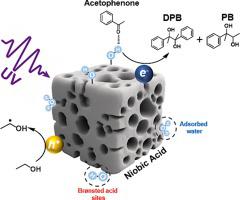Our official English website, www.x-mol.net, welcomes your feedback! (Note: you will need to create a separate account there.)
Niobium Oxides: The key role of hydroxylated surface on photocatalytic driven C–C reductive coupling of acetophenone
Journal of Catalysis ( IF 6.5 ) Pub Date : 2024-06-01 , DOI: 10.1016/j.jcat.2024.115580 José B.G. Filho , Leandro D. Almeida , Henrique F.V. Victória , Gustavo H.M. Gomes , Klaus Krambrock , Patricia A. Robles-Azocar , Marcio C. Pereira , Luiz C.A. Oliveira
Journal of Catalysis ( IF 6.5 ) Pub Date : 2024-06-01 , DOI: 10.1016/j.jcat.2024.115580 José B.G. Filho , Leandro D. Almeida , Henrique F.V. Victória , Gustavo H.M. Gomes , Klaus Krambrock , Patricia A. Robles-Azocar , Marcio C. Pereira , Luiz C.A. Oliveira

|
Aromatic diols play a pivotal role in various industries as crucial components of bulk feedstock and fine chemicals, particularly in pharmaceutical production. However, the complexity of the chemical reactions involved in their synthesis often poses challenges for achieving high yields and purity. This study introduces an alternative approach for the synthesis of 2,3-diphenylbutane-2,3-diol (DPB) and 2-phenylbutane-2,3-diol (PB) using niobium oxides as photocatalysts for C–C reductive coupling with acetophenone as the substrate. Niobium oxides were synthesized from commercially available niobic acid (HY-340) via calcination at various temperatures. The characterization data revealed the critical impact of thermal treatment on the acid-hydroxylated surface groups of niobic acid, which strongly influenced the photocatalytic performance. Therefore, niobic acid emerged as the most active photocatalyst, achieving yields of 32.0 % and 35.1 % for PB and DPB, respectively, after 2 h of UV irradiation. Control experiments were conducted in conjunction with electron paramagnetic resonance and electrochemical impedance measurements to elucidate the mechanistic pathways governing the formation of DPB and PB, and to shed light on the significant role played by the surface structure of niobic acid in influencing the photocatalytic performance. This study not only provides valuable insights into the synthesis of aromatic diols but also emphasizes the significance of tailoring the surface properties of niobium oxide catalysts to enhance reactivity in photochemical processes.
中文翻译:

铌氧化物:羟基化表面在光催化驱动苯乙酮 C-C 还原偶联中的关键作用
芳香族二醇作为散装原料和精细化学品的关键成分,在各个行业中发挥着关键作用,特别是在药品生产中。然而,其合成过程中化学反应的复杂性常常给实现高产率和纯度带来挑战。本研究介绍了使用氧化铌作为光催化剂与苯乙酮进行 C-C 还原偶联来合成 2,3-二苯基丁烷-2,3-二醇 (DPB) 和 2-苯基丁烷-2,3-二醇 (PB) 的替代方法作为基材。铌氧化物是由市售铌酸(HY-340)通过在不同温度下煅烧合成的。表征数据揭示了热处理对铌酸酸羟基化表面基团的关键影响,这强烈影响了光催化性能。因此,铌酸成为最活跃的光催化剂,在紫外线照射 2 小时后,PB 和 DPB 的产率分别达到 32.0% 和 35.1%。结合电子顺磁共振和电化学阻抗测量进行对照实验,以阐明控制 DPB 和 PB 形成的机制途径,并阐明铌酸的表面结构在影响光催化性能中发挥的重要作用。这项研究不仅为芳香族二醇的合成提供了宝贵的见解,而且强调了调整氧化铌催化剂的表面性质以增强光化学过程中的反应性的重要性。
更新日期:2024-06-01
中文翻译:

铌氧化物:羟基化表面在光催化驱动苯乙酮 C-C 还原偶联中的关键作用
芳香族二醇作为散装原料和精细化学品的关键成分,在各个行业中发挥着关键作用,特别是在药品生产中。然而,其合成过程中化学反应的复杂性常常给实现高产率和纯度带来挑战。本研究介绍了使用氧化铌作为光催化剂与苯乙酮进行 C-C 还原偶联来合成 2,3-二苯基丁烷-2,3-二醇 (DPB) 和 2-苯基丁烷-2,3-二醇 (PB) 的替代方法作为基材。铌氧化物是由市售铌酸(HY-340)通过在不同温度下煅烧合成的。表征数据揭示了热处理对铌酸酸羟基化表面基团的关键影响,这强烈影响了光催化性能。因此,铌酸成为最活跃的光催化剂,在紫外线照射 2 小时后,PB 和 DPB 的产率分别达到 32.0% 和 35.1%。结合电子顺磁共振和电化学阻抗测量进行对照实验,以阐明控制 DPB 和 PB 形成的机制途径,并阐明铌酸的表面结构在影响光催化性能中发挥的重要作用。这项研究不仅为芳香族二醇的合成提供了宝贵的见解,而且强调了调整氧化铌催化剂的表面性质以增强光化学过程中的反应性的重要性。












































 京公网安备 11010802027423号
京公网安备 11010802027423号